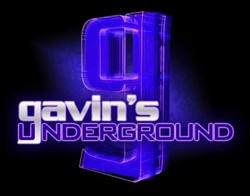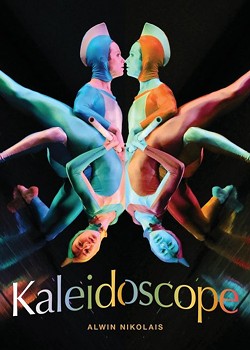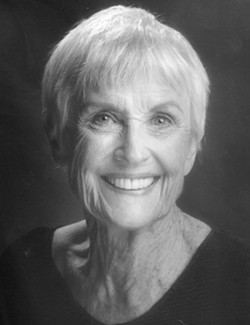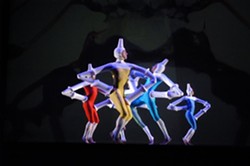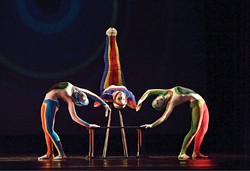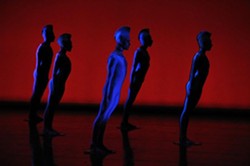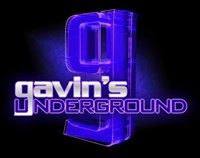Friday, February 3, 2012
Ririe-Woodbury: Kaleidoscope
Posted By Gavin Sheehan on February 3, 2012, 9:00 AM
Ririe-Woodbury has been on a pretty good roll this season, and as the dance company enters the second half we now come to the Family & Children's showcase of the year. --- Kaleidoscope brings together four dances from choreographer Alwin Nikolais, presented with disturbing clowns, arcade effects, elastic bands and electronica music for an evening of spectacular visuals in a space-like atmosphere. Even though it's geared toward a family audience, it's probably one of the more challenging and experimental shows you'll find this season.
Before the show hits the stage, we chat with Alberto del Saz, the artistic director of the Nikolais/Louis Foundation for Dance, as well as company namesake co-founder and managing director Joan Woodbury, about the production and briefly about their respective careers, plus thoughts on the dances and going into opening night.(Photos by Michael Manning & Fred Hayes)
Joan Woodbury & Alberto del Saz (Tito)
Gavin: Hello, Joan. First off, tell us a little bit about yourself.
Joan: I just loved to move from the get-go. Everything I did as a child which had meaning for me was movement. I lived on a farm until I was five, and I climbed hay stacks, jumped over fences, ran after the cattle, played in the field, ran after my father’s old truck. I loved to move. At age four, I took tap dancing lessons and my fate was sealed. I loved it. I made sure I was in all of the church musicals -- as I loved to sing, as well -- got hooked on ballroom dancing in high school, and started choreographing in high school and Branch Agricultural Jr. College in Cedar city when my teacher, and a wonderful woman Laveve Whetten, recognized that I had some talent and passion for dance, and advised me to go to the University of Wisconsin to study, which I did, and other things in my career just fell into place. I was hired at the University of Utah,as the first full-time dance instructor they had ever had, and began to immerse myself in dance, dance, dance.
Gavin: What first got you interested in dancing and what were some early influences on you?
Joan: Going professional was just another step in the process, not some earth-shaking event where you say,”Now I’m a professional.” You’re always a professional if you come to your craft with passion, commitment, striving to do your best at everything you do. Shirley Ririe and I met in the early '50s when I was teaching at the University of Utah and she at BYU, and decided to make a dance together, and then began working with some other professionals in a company called Choreodancers, doing tours in Utah, Nevada and California. We made our own profession. After that company disbanded in 1964, we began our company, and I think that if you consider a professional "one who is paid," we were really on the low end of the scale. Each of us made $141 the first year of our touring. We were doing it for the love of it, and certainly not the money. And I think that I have always loved to perform, and so dancing for pay is really no different than dancing for nothing. I have always tried to be present, communicate to whoever was watching, no matter what the audience. Though I must admit, it is thrilling to dance for a packed house, in an incredible theater like the Joyce Theatre in N.Y, or the Nico Milano in Cape Town, knowing that you are making a difference in peoples' lives through the medium of dance.
Gavin: Prior to starting up RW, what was your dance career like when you went professional, and what was it like for you performing for audiences?
Joan: I have always loved to dance, and to teach and to make dances. But my first love was always dancing. I had problems with my hips when I was about 45, and after a hip replacement realized that my real dancing career was over, so I poured my energy into teaching -- which I was doing at the University of Utah -- and choreographing, and found great satisfaction in doing both. I was also at the time co-managing the Ririe-Woodbury Dance Company with Shirley, and also spent time making sure that other dancers and choreographers had the opportunity to practice their craft, so keeping the company alive was very important to me.
Gavin: How was it for you transitioning to choreography, both teaching the art and crafting shows around the U.S. and for various countries?
Joan: Shirley and I started the company because we really wanted to dance, and this would be an opportunity to perform while we were also teaching and choreographing at the University. I have always felt that a person who continues practicing in his own profession can make the best teacher. You are always exploring and investigating, much the same way a scientist does research, as a practicing dancer and a teacher, and you can pass these qualities of curiosity and dedication on to your students. In the very early days, our company met in the evenings at the old dance studio on the U. After the students were finished with their work, we would meet together and choreograph and improvise together. Later, we moved down to the Capitol Theatre, and about seven years ago we moved over to the Rose Wagner theatre.
Gavin: What was it like starting up Ririe-Woodbury and helping establish an independent dance company in Utah?
Joan: You know, when we started the company, we had no role models.We just did it. We had no money and so we would put a little money in the kitty for costumes, and then when we had enough money from our performances in Salt Lake and surrounds, at the end of the year we would divide the funds among the dancers, and start over for the next year. We grew slowly, six dancers, Shirley and me and one manager in the beginning. Then finally, we could afford two support people, and later three. The break-through came in 1972 when the National Endowment was formed. We went to N.Y. to audition for two programs, “Artist-in-Schools” and “The Dance Program,” and were accepted on both of them. This was the beginning of our international touring, and of our ability to get the funding to continue. We became the company with the most touring requested in the country to conduct Artist in Schools residencies throughout the nation -- at one point, we were on the road for more than 40 weeks in one year. Foundations and individuals and the National Endowment for the arts have been very good to us, and we were doing good work and we flourished.
Gavin: How has it been for you taking on the managing director role over the years and overseeing the work coming out of RW.
Joan: It was just another chain of events for me to take over as managing director, though I an not so sure how good I was a managing director. I actually think that my daughter, Jena, who has taken over for me, is much better. However, I have always been good with finance,s and when a managing director left the company, and we hired an assistant artistic director, we knew that we didn’t have the funds to hire another manager, so I just slipped into the position, which I have very much enjoyed.
Gavin: Switching over to you, Tito: How did you begin your professional career, and what was it like for you performing both in dance and figure skating?
Tito: I first became a professional skater touring and performing with the "Circo Ruso," a Spanish circus that had two different rings -- the regular circus and then a skating ring; acts will switch between the two of them. This was some experience for a young 17-year-old fresh from winning the Spanish National Championship in figure skating. Soon after the circus, I traveled to France where I auditioned for Holiday on Ice International, getting the job right in the spot. I was performing the next day. For the following year, my time was spent in South America and central Europe performing for thousands of very enthusiastic skating fans. All this touring led me to take a trip to NYC, where I first was introduced to the Nikolais Louis Technique and aesthetic and I felt head over heels with the company and the approach to dance. A year later, I joined the company and the rest is history. Thirty years have gone by and I am still a total believer and as passionate as I was of this amazing dance philosophy.
Gavin: What brought you to the States, and how was it for you performing on a national level for television shows and high-profile exhibitions?
Tito: The main reason why I came to the USA was to study dance and explore the possibilities to get my foot in show biz. During my first couple of years in NYC, I taught figure skating, I worked in films and television as an extra, modeled for drawing classes and F.I.T., but my main job and passion was as a dancer with the Nikolais Dance Theatre. There is nothing more exhilarating than waiting in the wings to make your entrance onstage, knowing that your performance will transport audiences into a world of fantasy and wizardry. You become a catalyst and a wonderful dialogue takes place between you and the audience, but no words are exchanged; all happens with the kinetic excitement that is built on the that empty canvas that we call the stage.
Gavin: When did the opportunity come about for you to become the artistic director for the Nikolais-Louis Foundation for Dance, and how has it been for you running the company and having a say in the works coming out of it?
Tito: Well, it was a natural succession of events that took me to where I am now. I first began as a dancer with the company, then became a soloist and rehearsal director, then left the company for a year to do several projects. One was to perform Uncle Tom's Cabin with Bill T. Jones at BAM in NYC, a controversial and ground-breaking piece for many audiences. Later that year, I went to Japan to work in a special project by Utsio Amagatsu, artistic director of Sankai Juku. Upon my return to NYC from my trip to Japan, I was ask to rejoined the Nikolais Dance Theatre in a tour of India representing the State Department. After Nikolais's death in 1983, I became the artistic director with Murray Louis.
Gavin: Joan, when did you first hear about Kaleidoscope and what were your initial thoughts about it?
Joan: You know, Kaleidoscope is actually the name of one of Nikolais's dances and it has within it four sections: Discs, Pole, Straps and Clothes. We have named this concert Kaleidoscope because all of our titles this year are based upon some sort of light, and so it makes it a little confusing. We are going to perform a work called Tensile Involvement, Noumenon, Temple, and two works from Kaleidoscope: Discs and Clothes. We are also premiering a new work called Gallery that is in black light. I have been a friend of Nikolais since 1949, and during his lifetime, I believe that I saw most all of his works, and so as we determine which works are to be transferred to the company by Tito, we all get together and decide which ones of them are Nik’s special works, which ones are possible to tour, which ones would make the best programming, which ones we love the most, etc. Murray Louis, who was Nik’s partner during his life, is also involved in the selection, though not so much as of lately. I have loved working with Tito -- we work so well together and, of course, none of this could happen without him. I have a very good eye for giving credits to the dancers, and can keep the dances alive here when he has gone back to work. I also come from the same Nikolais philosophical background as I am an avid advocate of the Nikolais technique and philosophy. Nikolais gave me so much during my life that I am thrilled to be giving something back to him by making it possible for people to see his works -- live -- through the performances of the Ririe-Woodbury Dance Company
Gavin: How did the opportunity to bring these works to RW come about, and how has it been for the two of you working together?
Tito: I have known Joan since I started my career in NYC. She used to be one of the regular faces at the Nikolais-Louis school in NYC due to her long professional relationship with Nik. I always admired her passion and love for art in general, but dance is her life. As the artistic director of the Nikolais Louis foundation, I have a huge responsibility to keep these works alive and make the necessary adjustments to make them current and accessible to new audiences, and we couldn't make this possible without the Ririe-Woodbury dance company, and most certainly without Joan.
Gavin: What has it been like working with the dancers involved and putting the production together?
Tito: I have been working with some of these dancers for several years. There is a great rapport among all of them -- great chemistry between them -- which is essential for the necessary growth as a company. The new dancers have been challenged in many different ways, especially with the amount of new choreography that they had to learn, as well as learning about a new dance technique. They have embraced the work and they have allowed me to guide them in understanding the Nikolais aesthetic.
Gavin: What are your thoughts going into opening night and what do you think of the production as a whole?
Tito: We are all very excited to feel the enthusiasm of the audiences and especially the children when they watch these magical works. As a dancer, your reward is that magical place in the performance when time stands still and you lose yourself in the movement.
| Follow Gavin's Underground: |
On Topic...
-
Film Reviews: New Releases for April 12
Civil War, Escape from Germany, Coup de Chance, Hundreds of Beavers, La Chimera, Sting
- Apr 11, 2024
-
Film Reviews: New Releases for April 5
Monkey Man, The First Omen, Wicked Little Letters, Girls State, Scoop, Exhuma
- Apr 4, 2024
-
Music Plus: March 29
Das Energi Festival headliners, Ogden Twilight lineup
- Mar 29, 2024
- More Gavin's Underground » More Culture »
More by Gavin Sheehan
-
Gavin's Underground: End Of An Era
Nine and a half years of local entertainment blogging comes to an end.
- May 26, 2017
-
Torris Fairley
A quick interview with the up-and-coming SLC-based comedian.
- May 25, 2017
-
Cirque Asylum
A look into the dance school teaching unique forms of aerial arts.
- May 24, 2017
- More »


